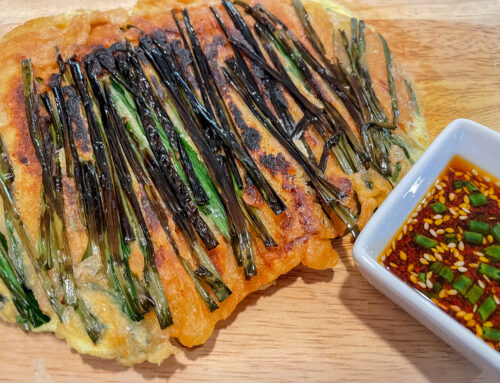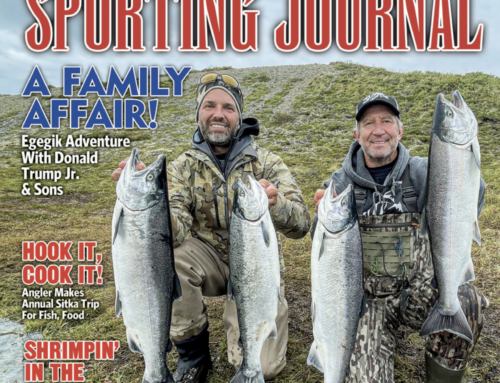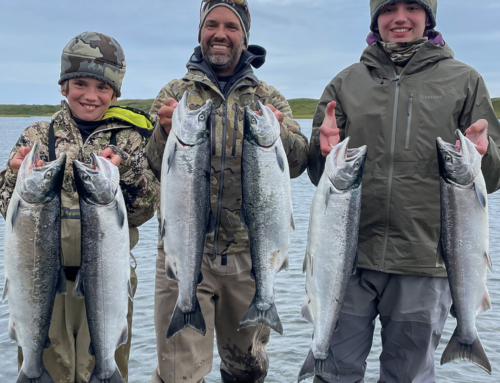
Families, friends, and strangers always have a good time at Becharof Lodge, where you can fish together or alone, if you choose. (Mat Hayward photo)
After more than an hour of watching friends catch coho after coho, I finally felt the urge to make a cast. The action had been sizzling, yielding salmon on just about every cast. Then the bite suddenly stopped, as it often does when fish move out of a hole in the river.
I walked a short distance upstream to where I’d been watching dorsal fins splitting the smooth surface of the calm flowing Egegik River. I knew of a little depression in that spot, one that often enticed traveling silver salmon to rest.
I baited my hook with freshly cured eggs, and no sooner had the cluster hit the water when a hard-fighting coho attacked. The same results came on the next cast, and the next. Twenty-one casts saw me land 21 coho, keeping four that were hooked too deep to release.
I lost a fish on the next cast, then landed five more in a row before losing another. On my 29th cast I landed my 27th coho, and kept it as it was hooked deep. It was a nice buck, prime for cooking. Though I could have kept fishing after keeping my fifth and final fish—the daily limit on Alaska’s Egegik River—I called it a morning.
Pouring a cup of coffee I sat back and watched friends continue to fish, reflecting on the many years of incredible memories I’d had on this amazing river.

You’ll never go hungry in this fish camp. (Mat Hayward photo)
In The Beginning
I first learned of the Egegik River in 2006. Having fished through-out Alaska for 33 years—and lived there for almost 9 of those—the Egegik is my favorite coho river in the state.
I know what you’re thinking. “Why would I go to Alaska when I have great salmon fishing so close to home, around the Great Lakes?” I used to think the same thing growing up in the Pacific Northwest, home to what I thought was the best salmon and steelhead fishing around. But once I went to Alaska, my fishing life changed; heck, my life changed.
My wife, Tiffany and I lived in Alaska’s Arctic for most of the 1990s, and I think that made me partial to the tundra. I like the openness offered by the rolling tundra surrounding the Egegik River as it leads to some of the most spectacular sunrises and sunsets I’ve seen anywhere in the world, and I’ve been fortunate to see many places. The wildlife exposed by the tundra is tremendous, from giant brown bears to wolves, ptarmigan to sandhill cranes, weasels to fox, and a plethora of bird life.

Greeting the sunrise with a hard-fighting coho is always a good way to start the day, and the norm for anglers at Alaska’s Becharof Lodge on Alaska’s remote Egegik River.
I’d fished with Becharof Lodge on the Egegik River for over a decade with the original owners. Then, in the fall of 2019 the lodge sold. Two men became equal partners in the lodge; George Joy, a longtime fishing and hunting guide who’d I’d known for years, and the best mechanic I’ve ever seen, and Mark Korpi, a building contractor from Astoria, Oregon who can craft a cabin from a 2×4 and sheet of plywood. These two are a great team.
The first thing George and Mark did upon acquiring Becharof Lodge was erect multiple cabins, which replaced the tents used for so long. This made it more welcoming for families, especially youth. They installed more flush toilets and showers, and continue improving upon the amenities at the lodge, including expanding and upgrading the electricity.
Two large structures with multiple rooms are now in place, along with smaller cabins and a comfortable dining hall with windows offering a commanding view of the river and surrounding tundra.

Alaska’s Egegik River is wide, shallow, and easy to wade, and coho can be fished multiple ways.
The entire staff is warm and welcoming, and Goni, the cook, among the best I’ve experience anywhere in Alaska. Mark Korpi’s daughters, Shelby and Cheyanne, help run things, are guides, and are the hardest working young ladies I’ve met. They helped build the new structures, and personally carried every piece of wood from the river to the building sites, something that has to be seen to be appreciated. David Stumpf, the head guide for many years, is one of the best anglers I’ve ever fished with. These are just some of the reasons I keep going back every season.
The Hot Spot
For many years this camp was a place dominated by older male anglers. Today, the newly constructed lodge and its pleasantness attracts many couples, families, and youth. “This is the best vacation we’ve had in 14 years,” I overheard one wife confiding in her husband as they prepared to fly home.
Though the lodge has satellite TV, it was never turned on—no one even asked for it to be. Mornings were spent taking in the sunrise with a hot cup of coffee or cocoa. Big breakfasts were the norm, something most people claimed they never ate at home, but didn’t let slip by.
Dinners were tasty with an abundance of food, and the friendly, comfortable atmosphere made it easy for people to help themselves to as much as they liked. Cookies were baked fresh from scratch each day. No one went hungry, ever, and we all went home a few pounds heavier than when we arrived.
While the comforts of camp play a big part in pleasing many people, it’s the fishing that brought them here. Many serious anglers wake up early and have their coffee and breakfast downed in time to be catching fish before the sun crests the horizon.
There are also those who sleep in, appreciating the freedom to do what they want on their vacation. They catch fish, too, a lot of fish.
One season thousands of coho held close to shore right in front of the lodge. After dinner for nearly half the season, anglers caught salmon after salmon right from shore. It made for a fun, unforgettable experience for many people. That’s only happened one other time in the history of the lodge.
I was surprised with the number of folks who were happy fishing only in the morning. They’d return to camp, enjoy a hot shower and lunch, take a nap, read, then sit atop the viewing platform and watch the local wildlife until appetizers were served. It was relax-ing and they reveled in it.
Brown bears were seen every day of the season that year, many coming close to camp, even licking the fish slime from the boats during the night. A wolf came into camp three times, pass-ing mere yards from the cabins. Willow ptarmigan, the state bird, abounded that summer, as they have the past four years, often mingling at the feet of anglers.

All fishing on the Egegik River is from the bank, and it’s a prime place for casting and retrieving plugs, even topwater models, for feisty silver salmon.
The fishing is simple, and the gravel, gently-sloping banks, easy for anyone to negotiate. The Egegik River is wide and shallow, and very little weight is needed to get presentations into the strike zone where coho salmon are holding and traveling.
Cured eggs can be fished on the Egegik River, which isn’t the case for all rivers in the region of Alaska. Be it drifted along the bottom or suspended beneath a float, there’s no contesting the value of a well cured egg for achieving high numbers of coho on this river.
Spinners can be incredible on the Egegik, with the Flash Glo Squid Skirt Spinner topping the chain of command. Spoons and jigs are very productive, too. A good twitching jig angler can expect consistent success on this river, with rubber legged versions being the hot ticket day in and day out. BnR Tackle Soft Beads are the best kept secret on this river, with the 32mm version opening many eyes. I’ve caught hundreds of coho on these over the past few years on the Egegik River.
Want to fish topwater for coho? This is the place, be it with a spinning rod or fly rod. Many anglers use only a fly rod all week long, stripping streamers, moving Wogs, and swinging surface pop-pers. Spey rod anglers love the vast amount of prime, open water to be fished.
STRYKER RODS
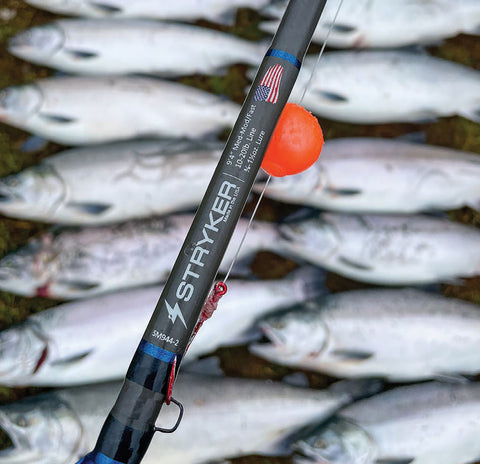
Last season Stryker Rods made coho rods for Becharof Lodge who started the season with 24 Stryker rods and ended the season with 24 Stryker rods. That, in itself, speaks to the quality construction of Stryker Rods.
“We had 112 guest last season and not a single Stryker Rod was damaged,” shared David Stumpf, Becharof Lodge’s head guide. “To get through a season with less than a dozen busted rods is rare,” he pointed out.
In 2019 Stryker Rods purchased Rogue Rods and moved the operation to Eugene, Oregon. Stryker Rods has assembled a who’s who team in the rod design and manufacturing world. Their focus is on quality, not quantity. “We’re not here to take over the market but to offer quality rods,” shares Duane Leavitt, one of three Stryker Rods co-owners. “Like many folks in the Pacific Northwest, we were all raised fishing, and love to fish as much as we can. We just want to give people options when it comes to high performance rods.”
Made in America, Stryker Rods blanks are becoming hugely popular, too. “A lot of people love building their own rods, as do many small businesses around the country, and we’re here to help,” concludes Leavitt. They offer a comprehensive line of salmon, steelhead and trout rods, along with rods for many other game fish and they’re continually expanding the line.
“Once folks started using the Stryker Rods at our lodge, they kept coming back to them,” shared Mark Korpi. “Some even marked them with colored tape to lay claim to them so others wouldn’t grab them; and bought some once they got home. That pretty much says it all, plus it saved us a lot of time and money having to ship rods in for repair at the end of the season.”
Bonus Round
The beauty of Becharof Lodge On The Egegik River is its proximity to even more remote places in Alaska. Flyouts take you to captivating streams where the pursuit of trophy class Arctic Char and grayling, along with rainbow trout, capture the essence of fishing in Alaska. Last summer’s wildfires destroyed a landing strip on the best, remote rainbow trout stream in the area, unfortunately.
If you want to experience brown bear viewing at famed Brooks Falls, that’s only a 25-minute floatplane flight from the lodge. Watching 1,500-pound bears gorge themselves on sockeye salmon is a sight to behold, and when a fight breaks out, hang on. This is one of my favorite things to do in all of Alaska.
An hour boat ride down the Egegik River finds you in the village of Egegik. Along the way you’ll often see bears, moose, beluga whales and unlimited bird life. In the summer, the bay of Egegik is home to some of the most intense commercial sockeye fishing in the world, but calm and quiet the rest of the year. It’s a fun village to walk around and envision what it must have been like for the indigenous peoples of the region hundreds of years ago.
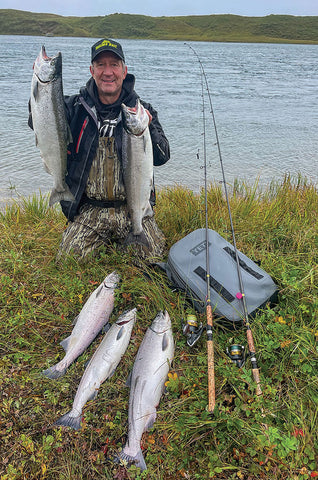
Author, Scott Haugen, has been fishing the Egegik for 16 years, and ranks it atop his favorite rivers in all of Alaska, for many reasons.
The more time I spend at Becharof Lodge, the less important catching high numbers of coho becomes. I’ve had multiple 100 coho days, as have many other anglers. Maybe it’s because I’ve grown more aware of all the other things this magical place has to offer. Maybe it’s because I find myself getting more pleasure watching others catch fish. Then again, maybe it’s because I know I’ll be back next year, and the year after that, and the year after that.
There are few places I keep going back to in Alaska, as there’s so much to discover in this vast state. But the Egegik River is an exception. Each year the coho run gets me excited, and the tranquility of this place continually captures my mind. The Egegik River is the best Alaskan fishing experience I’ve come to know, which is why I keep going back.
Source: Great Lakes Angler Magazine, May 2023 issue
Author: Scott Haugen


